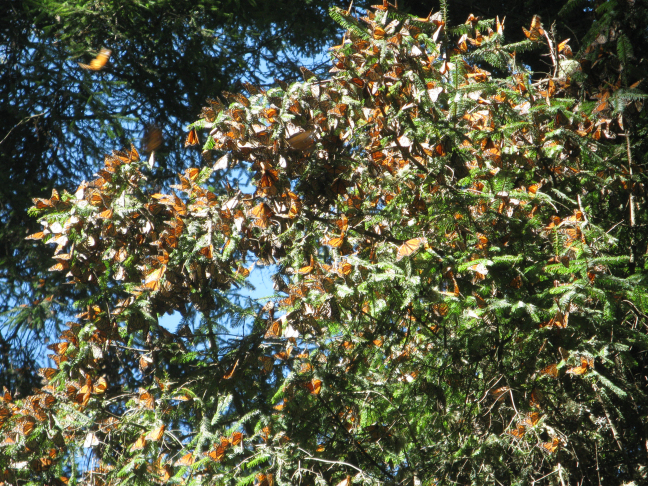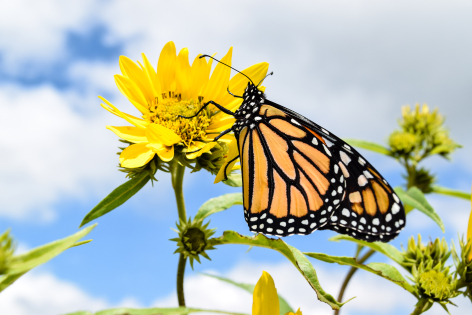
Monarch butterflies migrate to the same forested area in central Mexico every year. This gives scientists a convenient opportunity to measure the size of the population. Photo by Royce Bitzer. Larger image.
AMES, Iowa – Monarch butterflies are fluttering this way, and, with some luck, they’ll be more plentiful than in previous years when they reach Iowa later this spring.
During the winter months, scientists observed the largest overwintering monarch population in Mexico since 2007, said Steven Bradbury, a professor of natural resource ecology and management at Iowa State University. Bradbury is urging Iowans to maintain existing summer breeding habitat in the months ahead in the hope that such efforts throughout the Midwest can help sustain future monarch populations.
Monarch butterfly numbers have dropped sharply in recent years, in part due to a corresponding loss of summer breeding habitat. In 2013, the plight of the monarchs became so dire that scientists worried a single harsh winter could collapse the species’ continental migration, Bradbury said. But ideal weather conditions last year fueled a rebound.
Monarch butterflies migrate to the same forested area in central Mexico every winter. Measuring the area of forest canopy occupied by the butterflies gives scientists a convenient way of estimating the size of the population. The butterflies covered fewer than 2.5 acres in the winter of 2013-2014, the population’s lowest point in the last two decades. Last winter, however, the butterflies covered nearly 15 acres, which means a large population of butterflies is now migrating into the southern United States. As long as the weather remains favorable, Iowans can expect to see an abundant monarch population beginning in late May or early June, Bradbury said. He said maintaining that 15-acre mark consistently would put the species on much stronger footing when faced with a harsh winter in Mexico and other extreme weather events in the United States that could threaten the species.
The Iowa Monarch Conservation Consortium, a diverse partnership of 45 organizations supported by Iowa State University, the Iowa Department of Agriculture and Land Stewardship, and the Iowa Department of Natural Resources, is spearheading an effort to plant between 480,000 and 830,000 acres of new habitat by 2038. As part of ongoing outreach and education statewide, the Iowa Monarch Conservation Consortium encourages Iowans to follow best practices to maintain existing monarch habitat. Large and small habitat patches – including field edges, public parks, and roadsides – are critical to provide habitat connectivity across the landscape, Bradbury said, as is the responsible use of pesticides.
The consortium encourages the planting of new habitat that includes native forbs and milkweeds, the only plant species on which monarchs lay eggs and the only plant species monarch larvae eat. Establishing new habitat is essential to supporting the long-term recovery of the monarch population.
“Iowa is perfectly situated to lead the way in conservation efforts for the monarch butterfly. Since Iowa is located within the monarch’s core breeding range, every patch of milkweed habitat added here counts toward national monarch conservation efforts,” said Bruce Trautman, acting director of the Iowa Department of Natural Resources. “The recovery cannot succeed without Iowa.”
The consortium is working with municipalities as well as farmers to expand the amount of monarch habitat in the state. Bradbury said agricultural involvement is crucial because much of Iowa’s private lands are devoted to agriculture.
“You can’t get to Iowa’s target without a significant commitment of the non-crop land that’s part of the agricultural landscape,” Bradbury said.
Contacts
Steven Bradbury, Natural Resource Ecology and Management, 515-294-7315, spbrad@iastate.edu
Jacqueline Pohl, Entomology, 515-294-9980, jpohl@iastate.edu
Fred Love, News Service, 515-294-0704, fredlove@iastate.edu
Quick look
A sizable population of monarch butterflies is fluttering toward Iowa this spring. What can Iowans do to put the species on a more sustainable footing after years of decline? An Iowa State University expert discusses best practices for monarch conservation.

A monarch butterfly. Photo by Jacqueline Pohl. Larger image.